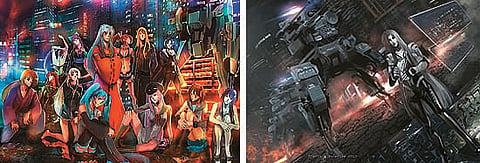In Samurai Champloo, set in the Edo period with an anachronistic hip-hop background, a brave young girl, Fuu, is on an eternal quest across Japan for the “samurai who smells of sunflowers”. Large, pointy-eyed creatures with elongated limbs and spiky hair etched in black and white cradle a narrative that’s easy on the eye. The “visual exaggeration” so enamoured Jaspreet Matharu, a 23-year-old graduate of Srishti College of Design in Bangalore, he started his own anime- manga blog. “If you speak to a Lord of the Rings fanatic, he’ll point out the deeper layers of story-telling in it. The same is true with manga—it’s complex and very aesthetic,” Jaspreet says. Manga comic books fist came out in Japan in the late 19th century. Manga now covers a broad range of genres like action and adventure, science-fiction and fantasy, romance, historical drama, sport, food and the paranormal. The interest has spread to Indian shores now, and there’s a swell in Indian otaku, as manga-crazies are called. Read from right to left, they use diverse narrative techniques and are also available in the animated, digitised form (anime). So, if the Naruto series is about an adolescent ninja Uzumaki who constantly searches for recognition and dreams of becoming the strongest ninja in his village, Bleach follows the adventures of Ichigo Kurosaki after he gains the powers of a Soul Reaper.
The Soul Reapers
Japanese manga comics are all the rage in Kidsville
Sixteen-year-old Rustam Chaudhuri of Shri Ram School in Gurgaon is a typical avid fan. “I’ve 30 volumes at home and I’m totally hooked. Unlike western comics, the simplistic style here excites me. I even visited a club in Japan recently to meet the author of Gag Manga,” he says. Class IX schoolmate Atreyi Menon adds, “The characters are absolutely goofy. It’s even got me interested in Japan and its culture.” Indeed, in school art classes, kids nowadays seem to be only drawing from these quirky characters. Shikha Osan, formerly a teacher at Shri Ram School, feels the extendable nature of manga makes it a fascinating domain to explore. “A couple of kids would show up at every class with sketches they’d done at home. Unlike older comics, the eyes are distinctive and there’s so much you can experiment with the hair,” she says.
Japan may be manga’s spiritual home, but devotees in India (especially in urban centres) are drawing enough parallels also. The Fourth Anime Convention, which was held at Noida near Delhi this September, saw nearly 8,000 people turning up, among whom were acclaimed Japanese art and comics historian Ryan Holmsberg, Mario Von Rickenbach, the video-game designer from Switzerland, and Bharath Murthy, filmmaker, teacher and mangaka. Festival director Nitesh Rohit says today children and adults have more access to a larger bouquet of manga as festivals, fan clubs and anime groups are sprouting all over the country. Mayank Rajput, a 23-year-old product manager in Gurgaon, started the Indian Manga and Anime Fans (IMAAF) community on Facebook six months ago and six months down, it’s got some 25,000 members. Pracheta Banerjee, a 19-year-old student of St Xavier’s College in Calcutta, and professional artist at IMAAF, says “We put out an ad on Facebook with manga- and anime-related parameters and 32 lakh people said they were interested. IMAAF is really an effort to consolidate all these people on one forum.” Recently, they even paid a manga tribute to Tendulkar on his retirement. “Next, we’re working on a plot around crimes against women in Gurgaon. There’ll be Indianised superheroes fighting evil.”

Fantastica Manga artwork by Pracheta Banerjee, an IMAAF artist and student of St Xavier’s College, Calcutta
Pushkar Dandekar, a member of the Mumbai Anime Club (3,500 members and counting), recalls how the club’s structure was first etched out casually on a tissue paper at a McDonald’s outlet in Mumbai three years ago. What started as random meet-ups and annual gatherings have now become a more serious vocation. Otaku debate, give vent to their artistic ideas and even dress up as manga characters in costume plays. And it’s not big cities, even in regions like the Northeast, the Guwahati Anime Club, Nagaland Anime Junkies and Manipur Anime Club have seen a growing number of followers.
Japanese manga artist Shohei Emura, who moved to Delhi in 2008, has collaborated with writer Vidyun Sabhaney to publish a couple of Jap-Indian hybrid comics. “If the marketing strategy is intelligently worked out, then manga could become even more popular in India,” says Emura. Stories like Mice Will Be Mice, which illustrate the growth of mice as giant monsters in experimental labs, or Chilka, which won the best comic book anthology award in 2012, blend the two oriental spaces in an evocative manner. But the most famous of them all is probably Yukichi Yamamatsu, who travelled to India in 2004 with a “missionary zeal” to spread manga culture in India. The resultant graphic novel, Stupid Guy Goes to India, is hilarious. As you travel with Yamamatsu, you see him navigate the sometimes-friendly, sometimes-brutal streets of Indian towns and cities. The book is irreverent and witty, presenting India exactly as it would look and seem like to a first-time foreign visitor.
Is there a Japanese approach to narratives that appeals to Indians? According to Bharath Murthy, mangaka, filmmaker and teacher, “There’s a historical connect with Japan because of Buddhism and the character traits are very relatable.” Bharath’s feature documentary, The Fragile Heart of Moe (2009), was part of a series on Japan’s capital called Tokyo Modern, which explored the subculture of Japanese comics. Well, that subculture has certainly found a fertile ground in India, with manga fans seeking each other out and growing fast.
Tags